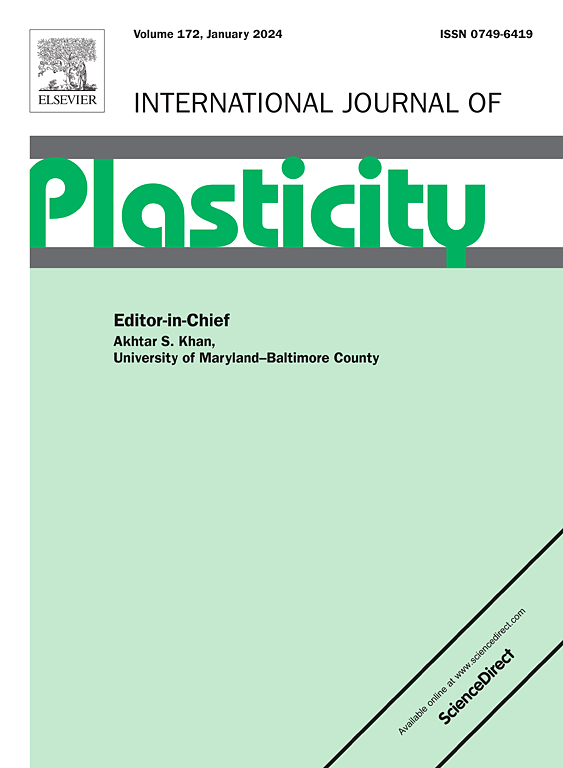具有纳米间距富溶质平面缺陷的超细晶粒使镁合金具有超强韧性
IF 9.4
1区 材料科学
Q1 ENGINEERING, MECHANICAL
引用次数: 0
摘要
Mg96.3Ho1.6Y1.2Zn0.8Zr0.1(。%)合金与亚微米超细颗粒包含nano-spacing solute-enriched平面缺陷开发表现出高的优势(屈服强度 = ∼382 MPa,极限抗拉强度 = ∼426 MPa)和良好的延性断裂伸长 = 19%,相比as-homogenized同行(屈服强度 = ∼160 MPa,极限抗拉强度 = ∼225 MPa,和断裂伸长 = 7.5%)。在热挤压过程中,通过第二Mg12(Ho,Y)Zn相诱导的粒子激发形核机制获得了平均晶粒尺寸为~ 940 nm的超细晶粒。在这些第二相晶粒周围形成了大量的超细晶粒。Ho/Y/Zn元素的加入降低了I1层错能,促进了I1型断层环的形成,促进了<;c+a>的活度;混乱。同时,纳米间距的富溶质平面缺陷(包括长周期层序结构和i2型层错)有效地阻碍了<;c+a>;位错,增加流动应力,同时促进新<;c+a>;混乱。因此,超细晶粒与富溶质平面缺陷之间的协同作用显著提高了屈服强度,促进了大量的非基底位错活动,从而显著提高了塑性。细化的二次变形Mg12(Ho,Y)Zn相进一步强化了合金,有效延缓了宏观裂纹的形成,提高了合金的延展性。该研究不仅为开发高强度、高塑性镁合金提供了有效的策略,而且为研究平面缺陷和位错之间的相互作用提供了新的见解。本文章由计算机程序翻译,如有差异,请以英文原文为准。


Ultra-strong and ductile magnesium alloy enabled by ultrafine grains with nano-spacing solute-enriched planar defects
Mg96.3Ho1.6Y1.2Zn0.8Zr0.1 (at.%) alloy with sub-micron ultrafine grains containing nano-spacing solute-enriched planar defects is developed to exhibit high strengths (yield strength = ∼ 382 MPa and ultimate tensile strength = ∼ 426 MPa) and good ductility (fracture elongation = 19 %), compared to the as-homogenized counterpart (yield strength = ∼ 160 MPa, ultimate tensile strength = ∼ 225 MPa, and fracture elongation = 7.5 %). Ultrafine grains with an average grain size of ∼ 940 nm is attained via particle-stimulated nucleation mechanism induced by the second Mg12(Ho,Y)Zn phase during hot extrusion. A substantial number of ultrafine grains are formed surrounding these second-phase grains. The addition of Ho/Y/Zn elements lowers the I1 stacking fault energy, facilitating the formation of I1-type fault loops and promoting the activity of <c+a> dislocations. Meanwhile, the nano-spacing solute-enriched planar defects (including long-period stacking order structure and I2-type stacking faults) effectively hinder the motion of <c+a> dislocations, increasing flow stress while simultaneously promoting the activation of new <c+a> dislocations. As a result, the synergistic effect between ultrafine grains and solute-enriched planar defects significantly enhances the yield strength and facilitates the numerous non-basal dislocation activity responsible for significantly improved ductility. In addition, the refined second deformable Mg12(Ho,Y)Zn phase further strengthens the alloy and effectively delays the formation of macrocracks to improve the ductility. This study not only present an efficient strategy for developing high-strength, high-ductility Mg alloys but also provides new insights into the interplay between planar defects and dislocations.
求助全文
通过发布文献求助,成功后即可免费获取论文全文。
去求助
来源期刊

International Journal of Plasticity
工程技术-材料科学:综合
CiteScore
15.30
自引率
26.50%
发文量
256
审稿时长
46 days
期刊介绍:
International Journal of Plasticity aims to present original research encompassing all facets of plastic deformation, damage, and fracture behavior in both isotropic and anisotropic solids. This includes exploring the thermodynamics of plasticity and fracture, continuum theory, and macroscopic as well as microscopic phenomena.
Topics of interest span the plastic behavior of single crystals and polycrystalline metals, ceramics, rocks, soils, composites, nanocrystalline and microelectronics materials, shape memory alloys, ferroelectric ceramics, thin films, and polymers. Additionally, the journal covers plasticity aspects of failure and fracture mechanics. Contributions involving significant experimental, numerical, or theoretical advancements that enhance the understanding of the plastic behavior of solids are particularly valued. Papers addressing the modeling of finite nonlinear elastic deformation, bearing similarities to the modeling of plastic deformation, are also welcomed.
 求助内容:
求助内容: 应助结果提醒方式:
应助结果提醒方式:


